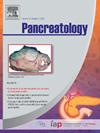Outcomes of percutaneous endoscopic versus endoscopic transmural necrosectomy for necrotizing pancreatitis: A propensity score-matched study
IF 2.8
2区 医学
Q2 GASTROENTEROLOGY & HEPATOLOGY
引用次数: 0
Abstract
Background
Few published studies exist that compare the outcomes of different endoscopic necrosectomy methods for necrotizing pancreatitis (NP). We compared the safety and efficacy of percutaneous versus transmural endoscopic necrosectomy for NP patients.
Methods
In this retrospective cohort study, we analyzed adult NP patients who underwent either percutaneous endoscopic necrosectomy (PEN) or endoscopic transmural necrosectomy (ETN), and compared safety and efficacy between the two groups. Propensity score-matched analysis and multivariable logistic regression analysis were conducted.
Results
A total of 280 patients were enrolled, among which 142 underwent PEN and 138 underwent ETN. There were differences in baseline characteristics between the two groups, including body mass index, C-reactive protein, systemic inflammatory response syndrome score. The incidences of sepsis, respiratory failure, and intensive care unit stay were higher among patients who underwent PEN than those who underwent ETN (all P < 0.01). Ninety-one pairs were matched with comparable baseline characteristics and severity. The incidence of postoperative complications, open surgery, clinical success, radiological success, collection recurrence, and reintervention were not significantly different between the ETN group and PEN group (all P > 0.05). Multivariate analysis also showed that the approaches (PEN vs ETN) was not associated with postoperative complications or mortality.
Conclusions
In real world setting, sicker patients tend to be more effectively managed through PEN compared to ETN. PEN demonstrates comparable efficacy and safety to ETN in the treatment of NP patients.
坏死性胰腺炎经皮与内镜下经膜坏死切除术的疗效对比:倾向评分匹配研究。
背景:很少有已发表的研究对坏死性胰腺炎(NP)的不同内镜坏死切除术方法的疗效进行比较。我们比较了经皮和经膜内镜坏死切除术治疗 NP 患者的安全性和有效性:在这项回顾性队列研究中,我们分析了接受经皮内镜坏死切除术(PEN)或内镜下经膜坏死切除术(ETN)的成年 NP 患者,并比较了两组患者的安全性和有效性。研究还进行了倾向评分匹配分析和多变量逻辑回归分析:共有 280 名患者入组,其中 142 人接受了 PEN 治疗,138 人接受了 ETN 治疗。两组患者的基线特征存在差异,包括体重指数、C反应蛋白、全身炎症反应综合征评分。接受PEN治疗的患者脓毒症、呼吸衰竭和重症监护室住院的发生率均高于接受ETN治疗的患者(均为P 0.05)。多变量分析还显示,手术方法(PEN 与 ETN)与术后并发症或死亡率无关:结论:在现实环境中,与 ETN 相比,PEN 能更有效地治疗病情较重的患者。在治疗 NP 患者方面,PEN 与 ETN 的疗效和安全性相当。
本文章由计算机程序翻译,如有差异,请以英文原文为准。
求助全文
约1分钟内获得全文
求助全文
来源期刊

Pancreatology
医学-胃肠肝病学
CiteScore
7.20
自引率
5.60%
发文量
194
审稿时长
44 days
期刊介绍:
Pancreatology is the official journal of the International Association of Pancreatology (IAP), the European Pancreatic Club (EPC) and several national societies and study groups around the world. Dedicated to the understanding and treatment of exocrine as well as endocrine pancreatic disease, this multidisciplinary periodical publishes original basic, translational and clinical pancreatic research from a range of fields including gastroenterology, oncology, surgery, pharmacology, cellular and molecular biology as well as endocrinology, immunology and epidemiology. Readers can expect to gain new insights into pancreatic physiology and into the pathogenesis, diagnosis, therapeutic approaches and prognosis of pancreatic diseases. The journal features original articles, case reports, consensus guidelines and topical, cutting edge reviews, thus representing a source of valuable, novel information for clinical and basic researchers alike.
 求助内容:
求助内容: 应助结果提醒方式:
应助结果提醒方式:


